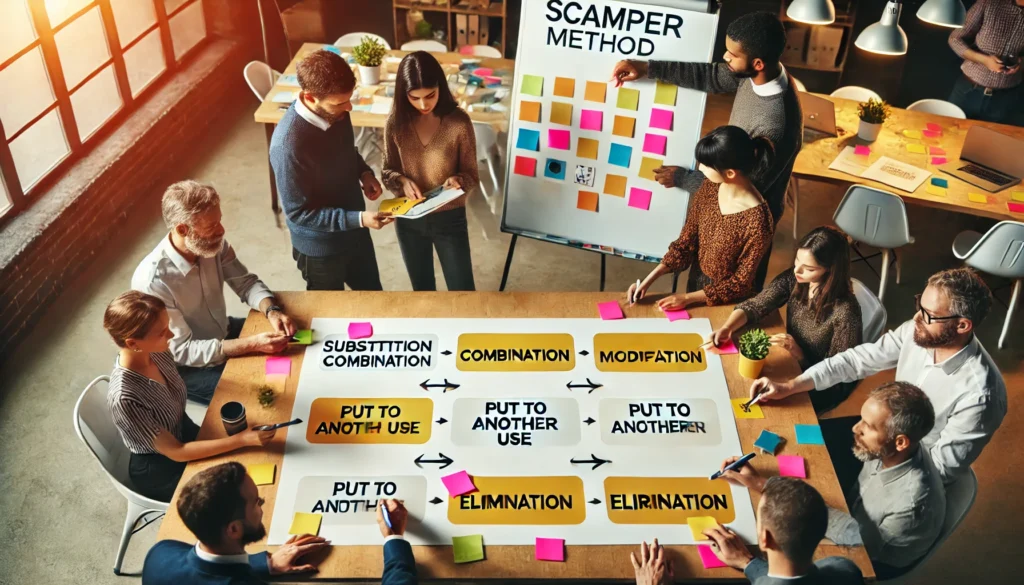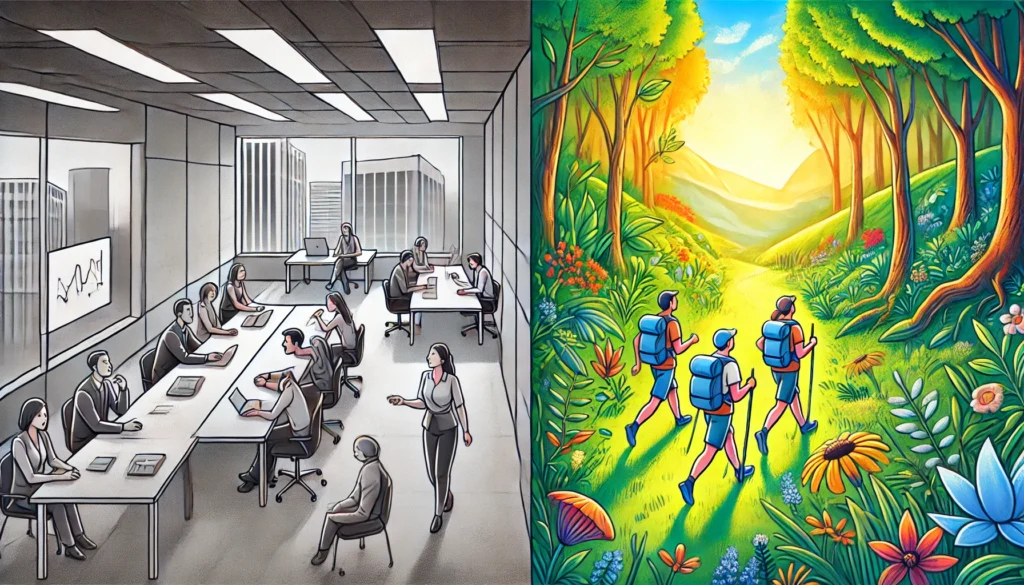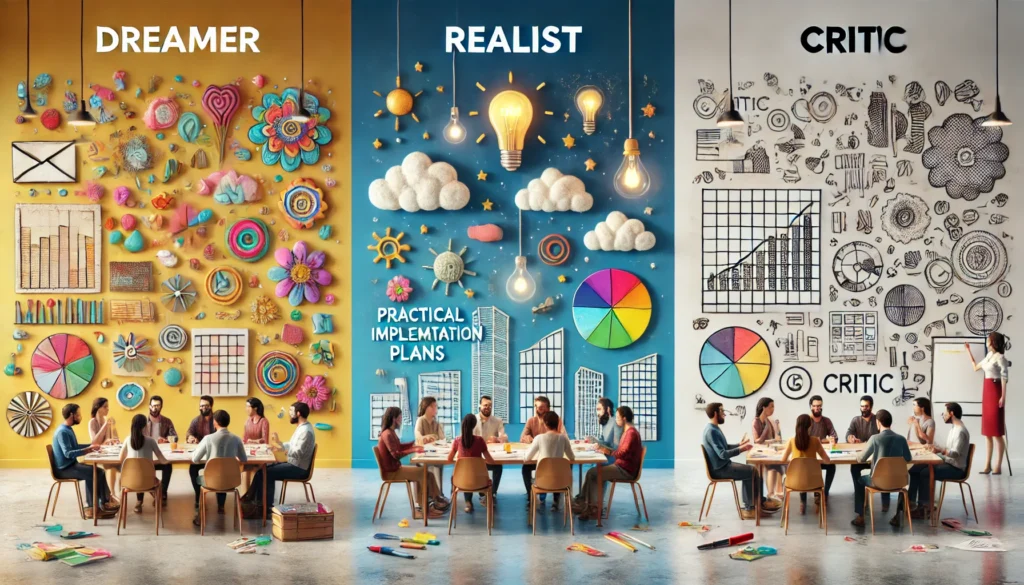Bring new momentum to your team!
Find out how our method can promote your innovation processes in a humorous and effective way.

“I haven’t failed. I’ve just found 10,000 ways in which it doesn’t work.” This quote is attributed to Thomas Alva Edison. A man who has registered over 1000 patents in his life, including the one for the light bulb. This example shows impressively that innovation is not a question of one brilliant idea that suddenly appears and is immediately perceived as the best idea in life. Rather, it is a numbers game. When it comes to finding ideas, quantity comes before quality. Filtering takes place later.
One big “but” should be mentioned right away: simply collecting lots of ideas, for example via an online tool where employees can submit their ideas, will not get anyone anywhere. Many ideas are only good if there is a procedure for dealing with them. Simply collecting more and more suggestions only leads to the idea providers becoming frustrated if there is never any implementation or feedback. That is why these and other methods of idea generation and further processing (such as design thinking, TRIZ, …) are so crucial. Once a framework has been established, one (of many) ideas can become a genuine innovation.
But how does it work? For example, how can we, especially in a team, stop the army of doubters who like to immediately crush every little idea with harsh criticism? The innovation phase of idea generation requires special rules to give ideas a chance to be seen. No matter how crazy you may sound at first. Will many of them remain crazy and impossible to implement? Yes! In any case! But for an idea that turns out to be a genuine innovation at second and third glance to get beyond the tender status of a sapling, rules and methods are needed for developing and handling ideas. Under the guidance of an experienced trainer and well implemented in a team, something completely new can emerge from the shared innovative power. Our customers use these methods in areas such as “expanding the business model”, “redeploying staff” or “further developing customer feedback”.
But how does it work? For example, how can we, especially in a team, stop the army of doubters who like to immediately crush every little idea with harsh criticism? The innovation phase of idea generation requires special rules to give ideas a chance to be seen. No matter how crazy you may sound at first. Will many of them remain crazy and impossible to implement? Yes! In any case! But for an idea that turns out to be a genuine innovation at second and third glance to get beyond the tender status of a sapling, rules and methods are needed for developing and handling ideas. Under the guidance of an experienced trainer and well implemented in a team, something completely new can emerge from the shared innovative power. Our customers use these methods in areas such as “expanding the business model”, “redeploying staff” or “further developing customer feedback”.

Everyone knows them. The people who respond to every new idea, no matter how small, with a “Yes, but…”. Even before you have finished the sentence, you think of something that contradicts it. The “yes, but – yes, and” method is an association method that makes the paralyzing influence of such a “yes, but” discussion on idea generation tangible. She then offers a solution on how to deliberately remove this killer phrase from the game. This requires a clear question. Examples of this are: “How can we ensure that the cordless vacuum cleaner vacuums 15 minutes longer with the same suction power?”, “How can we also offer management positions in job sharing without compromising the quality of the work?” or “To what extent can we involve influencers in our new campaign?”
Step 1: The moderator forms small groups of 4-5 people who are distributed around the room
Step 2: A test task that has nothing to do with the actual question is written down for all to see. Example “Plan a trip from Berlin to the moon”.
Step 3: The test task is implemented in three phases. Each phase lasts approx. 5 minutes
Step 4: In a short feedback round, the participants report on their experiences with the different phases of idea generation during the test task.
Step 5: Using the knowledge and momentum gained, the actual problem is now addressed using the “yes, and” method.
ATTENTION: There is NO “yes, but” round for the actual question.
A particular advantage of this method is that it illustrates the negative influence of the phrase “yes, but” in a humorous way. An impression that many participants will take with them into later professional situations. It also promotes the appreciation of individual ideas in the group, as there are always additions to the previous idea rather than rejoinders. At the same time, this weakens the fear of criticism and rejection of one’s own ideas and encourages active listening. A one-sided assessment is prevented.
One challenge is to avoid digressing too much from the actual topic in the “Yes, and” rounds. This is where a good moderator comes in, who should listen to the various groups in order to intervene if necessary. Without choking off the flow of innovation in the conversation, of course.
The method is particularly suitable for topics in the company that need new impetus or where there has been no further development for some time. It works for both products and services. At the same time, it promotes creativity and a change of perspective within the team. Employees with rather entrenched thought patterns in particular can benefit from this, as the method supports breaking out of these patterns in a humorous way and facilitates idea generation.
Find out how our method can promote your innovation processes in a humorous and effective way.

The SCAMPER method works with a checklist technique. It is particularly well suited to initiating lateral thinking processes (thinking without a predetermined goal). Gradually, different elements of a product or process are exchanged, changed, omitted or added. The different perspectives on one and the same product promote creativity and innovative idea generation. This means that even teams with no experience in innovation can get involved in the further development of products or processes and produce significant results.
Step 1: The moderator distributes the checklist. After all participants have had time to read through it, he explains the individual points and answers questions.
Step 2: The moderator then presents the problem to be worked on. This can be a product or process that the participants should modify using the checklist.
Step 3: The next step is to work on the list individually or in small teams. The moderator should allow sufficient time for this. Sometimes it takes a while for the participants to get used to the new way of thinking.
Step 4: The moderator collects the results and discusses them with all participants.
| Abbreviation | English | Meaning |
| S | Substitute | Replace – components, materials, people, processes |
| C | Combine | Combine – Mix with other additional functions or aggregates, overlap with service, integrate functionality |
| A | Adapt | Change from – Change functions, use a part of another element, an assembly, an aggregate, another process, another method |
| M | Modify | Increase or decrease – size, scale, change shape, vary attributes (color, haptics, acoustics, taste, smell, etc.) |
| P | Put (to another use) | Find other use(s) – Find other context for use, reformulate the scope of application |
| E | Eliminate | Remove elements, components, parts of a process – Reduce to core function, simplify |
| R | Rearrange | Reassemble – reassemble existing components and processes |
| R | Reverse | Turn around, turn the inside out – turn use upside down, find opposite uses |
This approach can shorten or release creative blocks. Especially when a team is used to working with long-established products or processes, looking at them through SCAMPERR glasses can help to gain a new perspective. The intellectual development of a product/process can also give rise to new products/processes. This allows the team to identify obstacles and limitations in the company that may not even have been noticed before. New solutions become possible. The common thread provided by the list makes it unlikely that you will stray too far from the actual topic.
What can be challenging about this approach for the team is that the list is initially perceived as too abstract, so it takes a while for results to emerge. However, the moderator should not finish working with the list too early! Persistence pays off at this point. In addition, the SCAMPERR method is not well suited for large groups, as otherwise summarizing the results would be too confusing. A maximum of 20 people makes sense.
The SCAMPERR method can be used very comprehensively and is therefore a very valuable method for finding and developing ideas. When “examining” a product with SCAMPERR, for example, completely new ways of using it can be developed. A sales process can just as easily be scrutinized, a process in the company can be made more secure or the use of certain marketing instruments can be critically examined. The only prerequisite for this is that an object exists to which SCAMPERR is applied. The method is therefore not suitable for developing completely new approaches, such as a brand name.
Book our Patent Booster Workshop and let your experts jointly develop groundbreaking ideas and conduct live patent searches.

The brainstorming method is probably one of the best-known methods of associative idea generation. Brainwalking is closely linked to this, but combines movement with thought processes. The well-known phenomenon of the ingenious idea while jogging, in the supermarket or on a walk has certainly occurred to everyone at some point. Creative thought processes run differently in combination with physical movement than when sitting. The brainwalking method is more time-consuming than pure brainstorming, but can lead to unexpectedly good results.
Step 1: One flipchart paper is hung up for every 2 to 3 participants. The same task is written on each sheet (variation: there are different tasks per sheet, or the same task is cleverly distributed twice around the room).
Step 2: In the first few minutes, the participants write down spontaneous ideas on the paper assigned to them.
Step 3: The individual stations are walked through by all participants and further associations to the ideas already written down are noted until everyone has been to each flipchart paper once. In order not to disturb the concentration and the flow of ideas of the individual participants. they do not talk to each other during the exercise.
Step 4: This is followed by the evaluation with 2 different options. First, the participants cut the flipchart sheets for each contribution with its associations into strips and lay them out visibly.
Movement and flow of thought can be combined particularly well in this exercise. The free association of ideas can proceed undisturbed; the method counteracts “killer phrases” and premature criticism by walking around and remaining calm. It is also well suited for groups that need a break, for example if the rest of the seminar takes place in a seated position. It can be used well for one, but also for several problems at the same time. More introverted participants in particular benefit here, as they do not have to present their ideas directly to the group.
The exercise can take place in a large room, but an entire building or an outdoor area would be better, where the positive influence of movement between the individual stations can be particularly effective. This space requirement can be a challenge. If this is not possible, it is worth getting creative at this point. For example, the participants could each do a lap of the stairwell before going to the next station in the same room. The inclusion of sufficient exercise is very important! Depending on the size of the terrain, the exercise can take quite a long time. When evaluating the answers, the moderator must ensure that ideas are not talked over.
Brainwalking is suitable for the development of new business areas, for example. By cleverly posing questions, interesting ideas can emerge from the collaboration of very different roles in the company (e.g. controllers, marketing experts, IT specialists). An exciting alternative could be to invite customers to this workshop. These bring additional perspectives that would not arise within the company. As the method is quite complex, it should rather be used for comprehensive questions. It is not suitable for smaller specific problems.

This creative method was supposedly mastered to perfection by the master of fairy tale adaptations, Walt Disney. It is particularly suitable for the evaluation and further development of ideas that have been generated, for example, by one of the first three methods discussed here. But new ideas can also be developed and at the same time given an initial classification. In this way, the wheat can be separated from the chaff. Ideas are viewed and evaluated from three different perspectives. As each participant takes on every perspective, it also creates greater understanding within the team for different roles and points of view.
Step 1: The room is divided into three stations. There is the dreamers’ corner, the realists’ corner and the critics’ corner. If you want to go the extra mile, you can also stimulate the imagination of the participants with suitable decorations.
Step 2: The exercise starts with a trial round without a predefined task. All participants go to a station at the same time and put themselves in the mood that the respective role requires of them. In the dreamer’s corner, participants can think of a wonderful, creative moment in their lives that had a very positive influence on them and their mood. The realists’ corner invites you to put yourself in a situation in which you have solved a problem practically, cleverly and with a certain hands-on mentality. In the critics’ corner, each participant puts themselves in a situation in which they have analyzed critically and objectively, perhaps even somewhat pessimistically.
Step 3: Now the moderator announces the task and the group begins in the
Step 4: Several runs may be necessary until an optimum result is achieved.
The Walt Disney method is particularly valuable if you want to break down participants’ entrenched thought patterns. As it can be used both to generate ideas and to further categorize existing ideas, depending on the issue at hand, it is versatile and easy for participants to understand and implement. It promotes group dynamics and mutual understanding of different roles in a company (manager, specialist, controller, etc.).
It is important to have a well-trained moderator who can take corrective action, especially with an inexperienced team. This ensures that the respective roles are not abandoned and that the participants do not restrict each other in the performance of their respective roles. You should also allow enough time for this exercise, as it may take several passes through the stations to achieve good results.
The Walt Disney method is particularly useful if you want to evaluate existing ideas that have not yet been further developed from different perspectives. This means that no area is neglected and the idea is put through its paces.

In the end, all methods of idea generation have one thing in common: in order to really move a company forward, the methods presented require a well-trained and experienced workshop moderator. It is the task of the moderator to keep the group on track, especially for teams that are still inexperienced in finding and developing ideas. It must not allow too many deviations from the method itself or the task set, for example. At the same time, it is necessary to have a sense of when a certain deviation could bring the decisive idea to light. A great deal of experience is required to ensure that a whole group of different characters and roles in the company pull together without anyone taking offense at corrections made by the moderator. An inexperienced moderator, perhaps paired with a new or inexperienced team, will therefore find it difficult to achieve the desired results.
These 4 effective methods of idea generation clearly show how important it is to get the flow of ideas going by taking an unconventional approach. In this way, the participants initially produce a certain amount of ideas without them coming under the direct influence of criticism. At the same time, however, the ideas are given a framework in which they do not float in a vacuum, but can be filtered and developed further at a later date. This is done on the basis of a subsequent evaluation using methods such as Walt-Disney or others. This approach is essential for promoting genuine innovative strength, brings the team closer together and can therefore take the company a big step forward.
Laden Sie unser kostenloses White Paper “Warum Brainstorming zur Innovationsentwicklung überschätzt wird” herunter und entdecken Sie mehrere wirkungsvolle Kreativitätstechniken
Als Innovationsberatung unterstützt TOM SPIKE Industrie- und Technologieunternehmen dabei, neue Produkte, Services und Geschäftsmodelle zu erdenken, umzusetzen und auf dem Markt erfolgreich zu machen. Die gezielte Entwicklung einzigartiger Ideen ist dabei nur einer von mehreren Schritten. Für viele Unternehmen ist ein geeigneter Innovationsprozess zu allen Schritten der Innovation entscheidend. Damit kann wiederholbarer Innovationserfolg gewährleistet werden. Bei der Entwicklung von Innovationsprozessen folgen wir einem partizipativen Ansatz und arbeiten eng mit Experten und Führungskräften des Unternehmens zusammen. Das ist aus unserer Erfahrung ein wichtiger Garant dafür, dass der Innovationsprozess akzeptiert und tatsächlich gelebt wird. Sowohl in der Prozessentwicklung als auch bei der Begleitung von Innovationsprojekten setzen wir auf fokussierte Workshopformate.

Pre-seed consulting, foundation consulting and startup coaching Do Startups need consulting?...
How a Patent Booster Workshop works R&D people are familiar with...
Or: How to solve any technical problem in no time at...
You are currently viewing a placeholder content from Google Maps. To access the actual content, click the button below. Please note that doing so will share data with third-party providers.
More Information